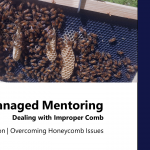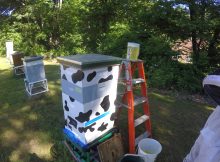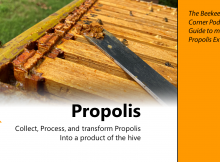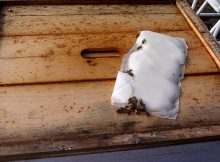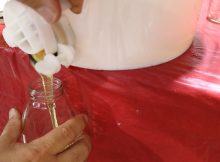In Episode 175 I spoke of having to dispatch (kill) one of my colonies.
I performed this disdainful task based on several inspections and considerations. In the end it was the risk to people in our vicinity that expedited the action and negated my decision to take alternative routes.
Some watch the video and have different reactions. I am not able to convey all the thought processes in detail in the video but here I can share some insights. I will not deliberate every detail but there are some actions that can be shared that are not apparent.
- I could see coming out of spring that this hive was aggressive. I do know that you can sometimes solve the problem by dividing the hive up and taking away some of its defensive force. I took a split of the colony (as mentioned in the video) which divided the colony in half. I hate to think what they might have been like if they were all still there. See #5
- My original intention was to requeen, as evidenced by the video, and split the hive up but the viciousness of the bees made the risk to high. See #6
- While the colonies behavior was a concern to me personally, I also had to consider the drones and genetics that were being cast into my neighborhood. I did not wish to harbor splits if the drones were going to still remain in attendance. Euthanizing the colony destroyed the drones too.
- What becomes of the equipment? One of the reasons I chose soap vs. some of the other options were based on practicality. In these Covid times of May 2020 it seems it would be hard to come upon dry ice, or Isopropyl Alcohol. It was hard to find dish soap. I landed on dish soap because I could procure it simply and I the plan is to hose everything down with simply water and that should render the combs reusable. Time will tell if this works out.
- The split hive is testy. I wanted to learn if a hive was left to requeen itself, would it result in a better disposition. Common wisdom is that drones often dictate the colony behavior and defensiveness. So how did that work out? The split is not docile. It is not even close to aggressive as its origin colony, but it is testy. When it is opened a lot of bees come out but nothing like the parent. The good news is so far it is not menacing the yard but I suspect it might get that way. The plan is to split the hive the hive and make several nucs to overwinter – all with new queens from known stock.
- There is a strategy that indicates if you take an aggressive hive and split it into smaller populations they lose their veracity. I am aware of that and considered breaking the hive up but experience in the past of doing this has not changed anything. Two years ago I had an aggressive hive (nothing like this one mind you) but challenging for sure. I split that colony up into three separate colonies and it resulted in a total of four colonies that were all jerks. Two of those colonies did not make through winter and one of them I solved by requeening. What became of the original. It was weak from the splits and I joined it with another hive – the parent of this colony.
- I have been asked if I could speculate the origin of this colonies genetics. I brought some colonies into my operation at one point from a friend (a person who is still a friend by the way). I will speculate that it likely started from some of those colonies but I am not compelled to go any further on the details.
- Some of the preparation can be seen in the video for tackling the problem but there was far more planning that took place. If you know me you can probably surmise that I toiled over this and in the end I am glad that I planned out my activities so well. Keep in mind that only one box was open to the air and had I not sealed off the boxes that were not being inspect, I think it could have been worse.
After seeing the video, or listening to the podcast episode related to these activities – I know some will still think that killing the hive was unnecessary. I respect different opinions. It all comes down to tolerance for risk. Some will say the hive was salvageable and it was unnecessary to dispatch it. I respect that we all have our center of reference and will admit that there was probably an avenue to come up with a plan. I think one important consideration is that NJ is the most populous state in the US and finding a place with enough space for remediation was not in the cards for me. Perhaps fatigue plays into that sentiment as I work for a living and my dance card is full – so finding time to execute an elaborate plan of finding a viable space for some intervention was not something I had the energy for. Others perhaps would have gone the extra mile – to each their own I guess.
That’s enough for now. For more detail of events listen to the full episode – #175 – Intervention.
Why the video?
Talking about this on the podcast is one thing, showing it through video is another. One cannot do justice to the aggression and the video shows it in all its glory. The other more compelling reason is once I decided to dispatch the colony I did some research on how and did not find that much on the topic. I figured, in a Kevin way of thinking, it might as well get documented. It was a lot of work to shoot the different videos to lay out the narrative and produce it. I hope that it has done the circumstance justice.


